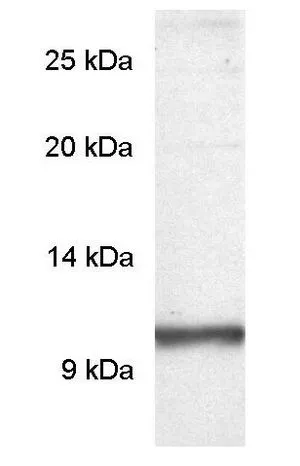
WB analysis of sheep retinal extracts using GTX25664 PDE6 gamma antibody.
PDE6 gamma antibody
GTX25664
ApplicationsWestern Blot
Product group Antibodies
ReactivityBovine, Human, Rat, Sheep
TargetPDE6G
Overview
- SupplierGeneTex
- Product NamePDE6 gamma antibody
- Delivery Days Customer9
- Application Supplier NoteWB: 1:500. *Optimal dilutions/concentrations should be determined by the researcher.Not tested in other applications.
- ApplicationsWestern Blot
- CertificationResearch Use Only
- ClonalityPolyclonal
- ConjugateUnconjugated
- Gene ID281977
- Target namePDE6G
- Target descriptionphosphodiesterase 6G
- Target synonymsGMP-PDE gamma; phosphodiesterase 6G, cGMP-specific, rod, gamma; phosphodiesterase, cyclic GMP (rod receptor), gamma polypeptide; retinal rod rhodopsin-sensitive cGMP 3',5'-cyclic phosphodiesterase subunit gamma
- HostRabbit
- IsotypeIgG
- Protein IDP04972
- Protein NameRetinal rod rhodopsin-sensitive cGMP 3',5'-cyclic phosphodiesterase subunit gamma
- Scientific DescriptionThe second messengers cAMP and cGMP are key regulatory molecules that are involved in a wide variety of signal transduction pathways, such as insulin secretion, platelet aggregation, smooth muscle relaxation, olfaction, and vision. Levels of cAMP and cGMP are regulated by their rate of synthesis by nucleotide cyclases and by their rate of hydrolysis by cyclic nucleotide phosphodiesterases (PDEs). PDEs form a superfamily of enzymes that catalyze the conversion of 3-prime, 5-prime-cyclic nucleotides to the corresponding nucleoside 5-prime-monophosphates. While mammalian PDEs are divided into major families based on their substrate specificities, kinetic properties, allosteric regulators, inhibitor sensitivities, and amino acid sequences, each family and even members within a family display distinct tissue, cell, and subcellular expression patters. This suggests that individual PDE family members are involved in discrete signal transduction pathways. ? PDE6 is the effector enzyme in the G protein-mediated signal transduction cascade in the visual system. There are five different subunits consisting of rod and cone specific catalytic subunits: alpha (Cone), alpha (Rod), and beta (Rod), the inhibitory subunit gamma, and subunit delta of unknown function (which likely interacts with many other proteins besides the PDE6 family). The catalytic core of the PDE6 system is comprised of alpha/alpha homodimers in the cone and alpha/beta heterodimers in the rod. The C-terminus of both the catalytic and inhibitory subunits is modified by methylation, myristyolation and prenylation which have been shown to be critical for proper complex assembly and membrane association.
- ReactivityBovine, Human, Rat, Sheep
- Storage Instruction-20°C or -80°C,2°C to 8°C
- UNSPSC12352203
